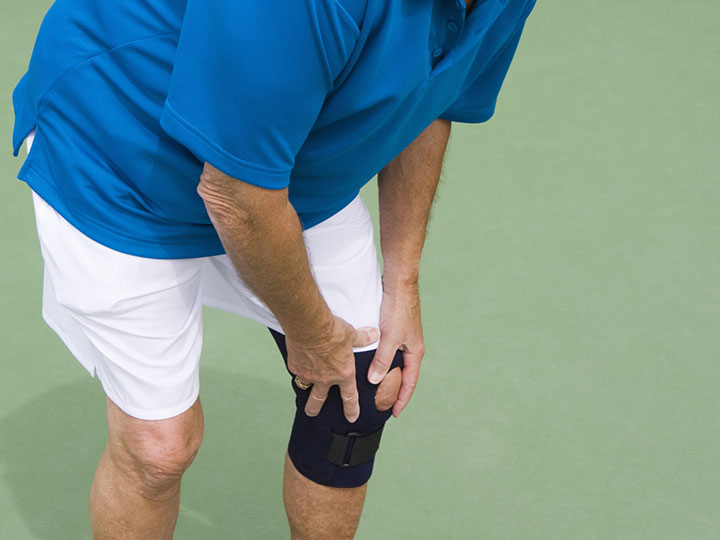Does silent inflammation explain rise in ‘Non-OA’ knee pain?
An Italian study [2] detects a high prevalence of inflammatory abnormalities in the knee joints of older adults, usually absent clinical signs of osteoarthritis.

By Rita Baron Faust, Rheumatology Network April 20, 2015
Knee pain and physical impairment is more prevalent among people over age 60 and has been increasing in recent years without an accompanying surge in osteoarthritis (OA) diagnoses. Now Italian researchers show reason to suspect a connection to inflammation.
Their analysis of data for about 500 men and women (ages 50 to 80) reveals ultrasound evidence of inflammation-related structural knee damage in 70%, but radiographic damage only in a small percentage.
The relationship between aging, joint damage, and inflammation is still unclear, they say. But their results suggest “a substantial contribution of inflammation in progressive impairment of joint function with age,” the authors state.
The cross-sectional clinical and ultrasound data come from a long-running prospective cohort study investigating the epidemiology and pathogenesis of atherosclerosis and joint disorders.
At baseline in 1990, and every 5 years since, men and women seen at Bruneck Hospital in Brunico, Italy, underwent clinical and laboratory exams. At a 2010 follow-up, 488 people were evaluated for joint swelling and knee pain (433 had ultrasound of both knees), as well as for levels of physical activity and daily function, comorbid diseases, and use of pain medications.
All but five of the group presented with inflammatory or structural abnormalities, most of them mild. Only around a third reported knee pain, and a mere 14% of this subset had signs of knee swelling on physical exam.
“The increase in degenerative joint abnormalities with age could have been expected; however, the observation of a high prevalence of inflammatory signs in the knee joint, even if mild in most cases, and the relative absence of clinical findings was astonishing,” the researchers comment.
Of those with knee pain, 82 had radiographic damage, but low Western Ontario and McMaster Universities Arthritis Index (WOMAC) clinical severity scores.
Although the study was not designed to look for clinical evidence of OA, subclinical inflammation-related joint damage may increase the risk of OA, they posit, either by creating an “inflammatory milieu” or due to accumulation of structural damage. (Physical activity did not correlate with structural damage in this study).
The researchers note that co-morbid diseases in the elderly, such as cardiovascular disease and diabetes, increase systemic inflammation. Earlier studies from the same cohort find diabetes an independent predictor for knee replacement.
In this study, those more likely to have knee symptoms and ultrasound signs of inflammation were older men with a higher body mass index and diabetes.
Two long-running US health studies first reported an unexplained rise in knee pain back in 2011. The ongoing National Health and Nutrition Examination Survey (NHANES) found the frequency of knee pain increased 65% in women and men in the 20 years after 1974.
Among participants in the Framingham Osteoarthritis Study, the frequency of knee pain doubled in women and tripled in men from 1983 to 2005. Although 24.7% of women and 16.5% of men report knee pain, x-rays demonstrated no change in the frequency of OA during that time.[1]
Source Rheumatology Network
| References |
- Increasing prevalence of knee pain and symptomatic knee osteoarthritis: survey and cohort data, Nguyen US, Zhang Y, Zhu Y, Niu J, Zhang B, Felson DT. Ann Intern Med. 2011 Dec 6;155(11):725-32. doi: 10.7326/0003-4819-155-11-201112060-00004. Full text
- Does subclinical inflammation contribute to impairment of function of knee joints in aged individuals? High prevalence of ultrasound inflammatory findings, D’Agostino MA, Iagnocco A, Aegerter P, Kleyer A, Zwerina J, Perricone C, Lorenzini R, Aschenbrenner F, Willeit J, Kiechl S, Schett G. Rheumatology (Oxford). 2015 Sep;54(9):1622-9. doi: 10.1093/rheumatology/kev032. Epub 2015 Apr 13. Full text
- The epidemiology of knee osteoarthritis: results from the Framingham Osteoarthritis Study, Felson DT. Semin Arthritis Rheum. 1990 Dec;20(3 Suppl 1):42-50. doi: 10.1016/0049-0172(90)90046-i.
- Association of Long-term Strenuous Physical Activity and Extensive Sitting With Incident Radiographic Knee Osteoarthritis, Chang AH, Lee JJ, Chmiel JS, Almagor O, Song J, Sharma L. JAMA Netw Open. 2020 May 1;3(5):e204049. doi: 10.1001/jamanetworkopen.2020.4049. Full text
- Prevalence of ultrasound-detected knee synovial abnormalities in a middle-aged and older general population–the Xiangya Osteoarthritis Study, Jiang T, Yang T, Zhang W, Doherty M, Zhang Y, Wei J, Sarmanova A, Hall M, Yang Z, Li J, Fernandes GS, Obotiba AD, Gohir SA, Courtney P, Zeng C, Lei G. Arthritis Res Ther. 2021 Jun 2;23(1):156. doi: 10.1186/s13075-021-02539-2. Full text
Also see
Inflamed Knees Common With Age Medpage Today
Most Healthy People Have Joint Abnormalities on Ultrasound Medscape Multispecialty
